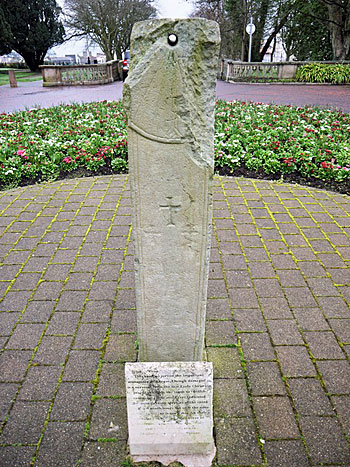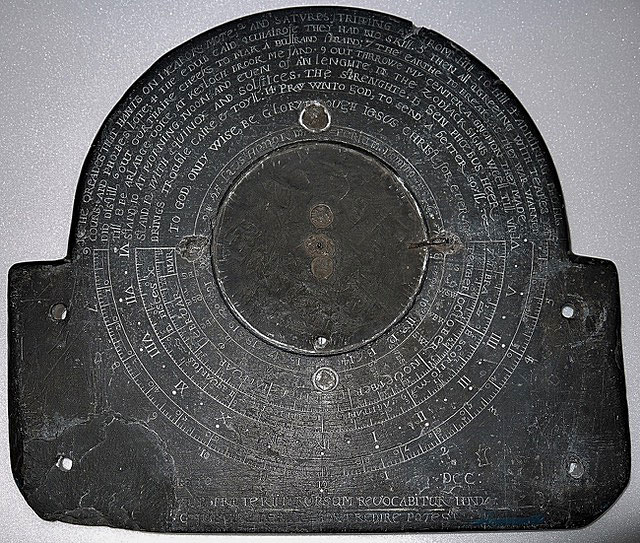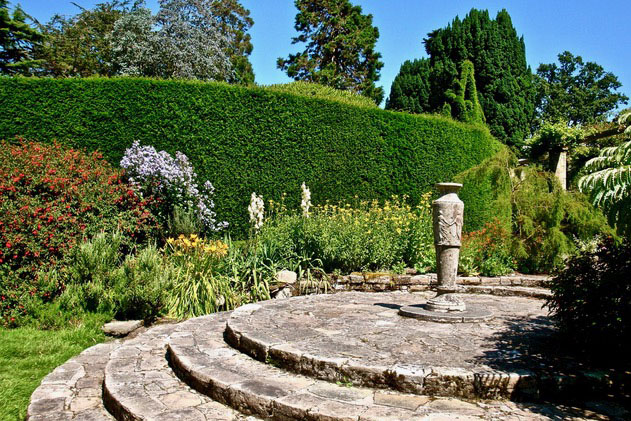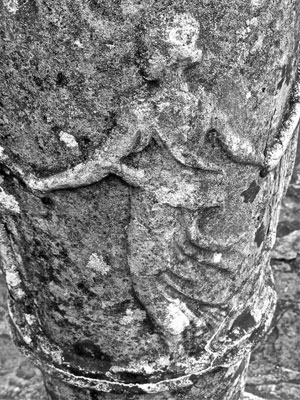I must say the fact that there was a County Down Sundial Trail was news to me before I started trying to research the Mount Stewart sundial for my garden tours. Then on the internet I came across the website of Michael J Harley which provides lots of information about sundials all around the UK and to which I am indebted for much of the information here. It is very informative and explains a lot of the technical details about how to situate your sundial and the differences in longitude etc. so if you have one it might be useful for you to check the positioning of your dial.
The history of sundials starts right back with the first recorded one in Egypt 1300BC, and the earliest representation of one, 250AD, in the UK at a Roman villa at Brading in the Isle of Wight. What must be the earliest one made in Britain, c.7th century Anglo Saxon on The Bewcastle Cross, Cumbria, is a vertical one (forerunner of the public wall clock). This is a canonical sundial, said to be by far the earliest English sundial to survive, and is divided into the four ‘tides’ which governed the working day in medieval times.
The word “tide” is derived from the Anglo Saxon for time – hence noontide, eventide. In the 13th century when mechanical clocks were coming into use, the sundial was used to regulate the clock. For the next 400 years they worked side by side, clocks for cloudy days and darkness, sundial for sunny days and regulation. As late as 1934 an advertisement appeared in the Nautical Almanac for a sundial for use in remote locations. Vertical sundials also appear in stained glass windows. Keen quizzers should note that the “gnonom” is the part of the sundial which casts the shadow and shows the time. Gnomon is a word that comes from ancient Greek and means “indicator”.
Our County Down Trail starts in Bangor which Mr Harley describes as “a popular seaside resort with a pier and marina”, and ends in Newcastle “where the mountains of Mourne sweep down to the sea”. The trail goes through some lovely scenery and if you start early on a summer morning you should be able to view all of the dials in one day. Most dials are listed on the British Sundial register but not all, so of our seven only four are numbered. Here they are:

Bangor Monastery Dial
British Sundial Register (BSR) No: 4219
In the Rose Garden in front of Bangor Town Hall (formerly Bangor Castle - built 1847) stands a vertical stone dial 1500mm high 300mm wide by 200mm thick dated circa 900 A.D. Originally located in St Comgall’s ancient monastery, it was relocated to the Castle over 100 years ago. Only five timelines of a possible twelve remain on the damaged 'U' shaped head and nothing remains of the gnomon but the hole in the slab where a wooden or metal gnomon would have fitted. Three crosses are carved on the stele.
Nothing now remains of the original buildings of the monastery. In the Private Chapel at Clandeboye, however, may be seen, built into the wall, the shaft of a Cross, which was found in the Abbey precincts. This is a c8th century fragment of a Celtic High Cross, which may have stood on “ the Cross Hill” adjacent to Bangor Castle. Leanne informs me that it is indicated on the Raven Maps that are on permanent display in the Plantation Gallery. Those on display are rotated but the Bangor map that features ‘Cross Hill’ is reproduced as the large-scale mural on one of the walls and you can zoom in on the map via the interactive facility.
The Bangor Abbey Dial
BSR No: ?
In the North Down Museum a display is dedicated to what the monastery might have looked like, due to be updated, and when it is, you will find a John Bonar sun, moon and tide slate dial, 400mm by 350mm by 15m thick, dated 1630. Originally designed for Bangor Abbey Church on the site of the ancient monastery, it too was removed to the Castle over 100 years ago.
This is an equatorial dial which means that it should be set up at an angle parallel to the equator so that the summer sun shines on the upper face and in winter on the lower face, which is also elaborately carved. It had movable arms one of which was fitted with weights, like an astrolabe, and could be turned until the moon appeared in the eye-piece. This eliminated the need for a shadow, and the dial could have been used whenever the moon was visible. The dial also has a wind rose, with the name of a port opposite each point of the compass. The compass bearing is what is called the 'port establishment', which very roughly gives the direction of the moon at the high tide for the particular harbour. Ayr, London, Bristol, Dublin and Cork are among the thirty places featured. The dial is covered with mottos and verses in Latin and Scots. One of only four known by Bonar, an early 1600’s Ayr school teacher, another is in the archives of the Drumfries Museum, Scotland.

The museum contains many interesting local artefacts, has a gift shop and cafe, and is not far from the Walled Garden, also with a cafe, so worth a visit!
The Mount Stewart Dial
BSR No: 3608

Leaving Bangor we go towards Newtownards and drive down the Portaferry Road towards Greyabbey. After about seven miles we come to Mount Stewart House, Gardens & Temple of the Winds, former home of the Marquesses of Londonderry, now administered by the National Trust. An 18th/19th century property with one of the most important gardens in the country, it provides a good day out for the whole family. Here in the Lily Garden is the object of our visit, a circular brass dial 200mm in diameter mounted on a 1200mm high pillar. Around the base are featured classical ladies dancing. These are the Horae in Greek mythology, goddesses who represent the seasons and the natural portions of time.

Together with the ornate wrought iron gate nearby, this sundial came from the Londonderry hunting box at Springfield in Rutland, and was previously situated in the Mairi garden before it was moved to its present position at the steps leading from the Sunk Garden. Traditionally, a motto may appear on the dial. This is usually in the form of an epigram: sometimes in Latin, sometimes in English. Reflections on the passing of time and the brevity of life are popular but often are humorous witticisms or puns on the same subject, such as: I am a sundial, and I make a botch, Of what is much better done by a watch. Or Life is but a shadow: the shadow of a bird on the wing, Today is Yesterday’s Tomorrow, Be True to each other as this Dial is to the Sun, or the imperative Begone about Thy Business! The doleful, Si Sol deficit, respicit me em, translates as If the sun’s gone, nobody looks at me.
The Mount Stewart dial sports a cheerier version:
Serene I stand among the flowers
And only count life's sunny hours
For me dark days do not exist
I’m a brazen faced old optimist
In a digression from the sundial theme I must mention that the design of Mount Stewart’s little folly, the Temple of the Winds, is based on the octagonal Tower of the Winds or Horologium in Athens. Built in the 1st century BC by astronomer Andronikis to measure time it contained a water clock to record the hours when the sun was not shining. It indicated the eight winds from which it got its name and also displayed the seasons of the year and astrological dates and periods. Some water clocks rang bells and gongs, others opened doors and windows to show little figures of people, or moved pointers, dials, and astrological models of the universe.
The National Trust cafe serves fresh seasonal food, there are house and garden tours, a plant shop, second hand books, National Trust souvenirs, and an antiques corner.
The Nendrum Dial
BSR No: 3614
From Newtownards take the A21 to Comber and turn off towards Killyleagh, turning off when you see the sign for Mahee island. A delightfully winding scenic road takes you through some residential areas then brings you into sight of Strangford Lough. Crossing the causeway onto the island there is a small lay-by for parking and a gate for free access to the Nendrum Monastery site. A little visitors' centre tells the story of the monastery founded in the 5th century, the grounds of which included orchards, gardens, arable farming fields, a guest house and pasture for animals. Ruins in this lovely dry stone-walled and green-swarded site include the remains of a round tower, stone enclosures and a church with lovely views over the lough. Here you will find a vertical stone dial 1900mm high 400mm wide by 150mm thick dated circa 900 A.D., roughly the same period as the Bangor Monastery Dial. It was reconstructed from pieces found during excavation in 1924. On the way to Nendrum you will have passed a tide mill dating from about AD619, the oldest excavated tide mill in the world. Take a picnic, your binoculars and don’t forget your camera for capturing magnificent views over Strangford Lough.
The Corbally Dial
BSR No: ?
Located on the Mall, Down County Museum, the erstwhile Downpatrick Gaol, has some restored cells and houses exhibits on local history. The museum has eight slate dials, some of them damaged, in its archives, unfortunately not on display. One of these, an unusual horizontal dial, is 490mm by 395mm wide, The smaller of the two central dials is delineated for Jerusalem and the main dial is for Corbally 5km east of Banbridge. There is an eight point windrose at the base of the gnomon. The four subsidiary dials, one at each corner of the plate are for Savanna, Calcutta, Botany and New York. The Botany gnomon is missing, the others are bent. The quotations are in Latin and English, I shew by the kindness & splendour of the sun, Life in its greatest vigour is altogether vanity, Sol gloria spherae - Sun, glory of the earth, Brevis hominum vita - Human life is short.
The dial was made for a James Murry in 1834 by Joseph McNally. There is a Places - Lat & Long table between Jas Murry - J McNally names, for the five locations delineated. The method of showing the date is unusual. James Murry may have been a shipowner who lived in Portaferry around that time.
There is another McNally dial in the museum but one of the corner subsidiary dials is broken off and missing. You can view these dials by ringing ahead first to enquire if it is possible on 028 4461 5218. Perhaps a good stop on one of our Away Days with the Society?
The museum has a good cafe and a small gift shop, and is handy for visits to the Cathedral, The Mound of Down, and the town centre.
The Tollymore Dial
BSR No: 3616
Head for Newcastle and take a stroll into the 500 hectare Tollymore Forest Park at the foot of the Mournes. At the entrance to the park high up on the octagonal belfry tower of Clanbrassill barn just below the clock is a painted vertical stone dial 700mm high by 600mm wide. The barn was built by James Hamilton, Lord Clanbrassill c.1760 and the clock and bell are dated 1785.
A walk along the Shimna river is marked by many curiosities, natural and artificial - rocky outcrops, bridges, grottos and caves. Elsewhere in the park the tree lover can examine experimental forest plots - some of exotic trees such as monkey puzzle and eucalyptus - or admire the tall giant redwoods and Monterey pines. Oak wood from Tollymore was the preferred material for the interiors of the White Star liners including the Olympic class RMS Titanic.
Here the official trail ends, but perhaps some day we will have another stop at the Ulster Folk & Transport Museum at Cultra. Yes - they do have sundials, but when I enquired I was told they had a small number in storage not on display and my correspondent didn't know if they were on the register.
Of course when checking the time you have to remember when the clock changes and adjust accordingly. Summer time, brought in as a wartime efficiency measure in 1916, was campaigned for by an Edwardian Kent builder, Wm Willet who died in 1915. He had noticed that people were still asleep when the sun was up in summertime. In 1907 he published a pamphlet called A Waste of daylight but was unable to convince others of his ideas. A commemorative vertical sundial was erected in Willet’s memory at Petts Wood, near Bromley, Kent, renamed Willet Memorial Wood, now in the care of the National Trust. With its motto, horas non numero nisi aestivas - I only count the summer hours - the Sundial is permanently set to British Summer Time.
